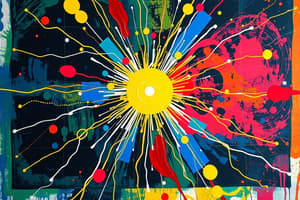Podcast
Questions and Answers
What are the two main sources of magnetic fields?
What are the two main sources of magnetic fields?
- Heat and sound
- Magnets and the movement of electric charges (correct)
- Gravity and friction
- Magnets and light
How do magnetic fields typically flow around a magnet?
How do magnetic fields typically flow around a magnet?
- In zig-zag patterns
- In circular paths from south to north
- In circular paths from north to south (correct)
- In straight lines from north to south
What is the role of magnetic field lines in visualizing magnetic fields?
What is the role of magnetic field lines in visualizing magnetic fields?
- To indicate the material of the magnet
- To show the temperature of the magnet
- To represent the direction and strength of magnetic fields (correct)
- To demonstrate the size of the magnet
According to the 'no-crossing rule,' what is a key characteristic of magnetic field lines?
According to the 'no-crossing rule,' what is a key characteristic of magnetic field lines?
What happens to the magnetic field strength when the field lines are closer together?
What happens to the magnetic field strength when the field lines are closer together?
How do similar poles of magnets interact with each other?
How do similar poles of magnets interact with each other?
What happens when a magnetic field passes through an electric current?
What happens when a magnetic field passes through an electric current?
How do electromagnets work?
How do electromagnets work?
Which real-world application uses magnetic fields to convert electrical energy into mechanical energy?
Which real-world application uses magnetic fields to convert electrical energy into mechanical energy?
What does MRI stand for in the context of the text?
What does MRI stand for in the context of the text?
Study Notes
Class 7 Electricity and Magnetism: The Mysterious World of Magnetic Fields
Imagine tiny magnetic forces guiding compass needles without touching them, or currents flowing through wires to create circuits that light up your room. These concepts and more can all be traced back to the fascinating world of magnetic fields, which we'll explore together in the context of a class 7 student's understanding of physics.
Magnetic fields are the invisible regions around magnets where magnetic forces can be observed. They're created by electric currents or the motion of charged particles like electrons. This field can influence other magnets, causing them to align or repel each other, even if they're separated by a distance.
Magnetic Fields and Their Properties
Magnetic fields exhibit certain consistent properties:
- Sources of magnetic fields: Magnets and the movement of electric charges are the two main sources of magnetic fields.
- Direction of magnetic fields: In general, magnetic fields are circular and they flow around the magnet from its north pole to its south pole.
- Magnetic field lines: Magnetic field lines visualize the direction and strength of magnetic fields. They always point in the direction the north pole of a compass needle would point.
- Magnetic field lines do not cross: This is the so-called "no-crossing rule," which means that the lines are continuous, never intersecting each other.
- Magnetic field strength: The magnetic field strength is higher where the field lines are closer together.
The Influence of Magnetic Fields on Charged Particles
As we learned, magnets exert forces on other magnets and on charged particles. When a magnetic field passes through an electric current, it causes the current to move in a circular path, creating a magnetic field of its own.
The forces that magnetic fields exert on charged particles can be used to demonstrate various phenomena:
- Magnetic attraction and repulsion: Similar poles of magnets repel each other, while opposite poles attract.
- Magnetic deflection: Moving a magnet near a current-carrying wire will cause the wire to bend.
- Electromagnetic induction: Changing magnetic fields can induce electric currents in conductors.
Applications of Magnetic Fields
Magnetic fields have numerous real-world applications:
- Motors: Electric motors use magnetic fields to convert electrical energy into mechanical energy.
- Electromagnets: These are coils of wire that generate magnetic fields when current is passed through them. They are used in devices such as loudspeakers.
- MRI (Magnetic Resonance Imaging): This medical imaging technique uses a strong magnetic field and radio waves to create detailed images of the body's internal structures.
As you can see, the study of magnetic fields is not just about understanding what magnets can do; it's also about the fascinating ways in which they can be utilized to improve our lives. So, the next time you marvel at the lights in your room or the MRI scan at the doctor's office, remember that it's all thanks to the mysterious world of magnetic fields!
Studying That Suits You
Use AI to generate personalized quizzes and flashcards to suit your learning preferences.
Description
Test your knowledge of magnetic fields, their properties, and applications in this quiz designed for class 7 students studying electricity and magnetism. Explore how magnetic forces influence compass needles, electric currents, and real-world technologies like MRI scanners.




